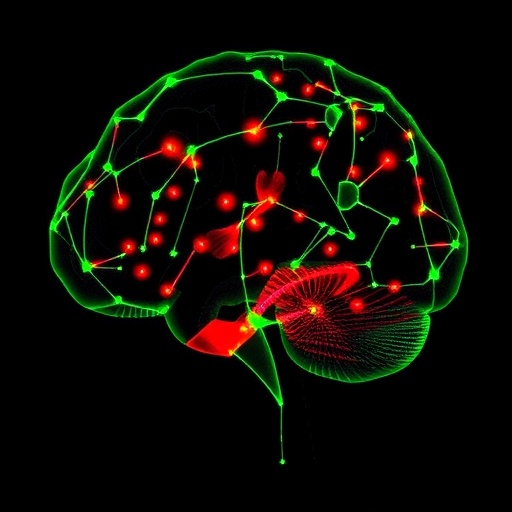In an exciting leap forward for neuroimaging, researchers have unveiled a groundbreaking technique combining multi-photon, label-free photoacoustic and optical imaging to visualize NADH—an essential metabolic coenzyme—in brain cells with unprecedented clarity and depth. This innovative approach, recently detailed in the journal Light: Science & Applications, promises to transform our understanding of cerebral metabolism and neural function by enabling non-invasive, high-resolution imaging of endogenous molecules without the need for synthetic labels or dyes. The development marks a significant milestone in brain research technology by unlocking new vistas into cellular bioenergetics and dynamics.
At the heart of this breakthrough lies the unique capability to capture the intrinsic contrast generated by NADH through multi-photon excitation processes in living brain tissue. NADH, or nicotinamide adenine dinucleotide in its reduced form, plays a pivotal role as a metabolic cofactor, participating in myriad redox reactions essential for ATP generation and overall cellular respiration. Its fluorescence and photoacoustic signatures provide a direct window into the metabolic state of neurons and glia, offering real-time insights into brain health and disease at the cellular and subcellular levels.
Unlike traditional fluorescence imaging that often demands exogenous fluorescent dyes or genetically encoded reporters, this novel methodology exploits label-free multi-photon photoacoustic imaging to detect NADH’s endogenous signals. By employing longer-wavelength near-infrared excitation, the technique achieves deeper tissue penetration with reduced photodamage and scattering. This results in high-contrast images that reveal the spatial distribution and dynamics of NADH within the complex architecture of brain cells, all while preserving physiological conditions.
.adsslot_6VtGevyflY{ width:728px !important; height:90px !important; }
@media (max-width:1199px) { .adsslot_6VtGevyflY{ width:468px !important; height:60px !important; } }
@media (max-width:767px) { .adsslot_6VtGevyflY{ width:320px !important; height:50px !important; } }
ADVERTISEMENT
Central to the imaging system is the innovative integration of photoacoustic and optical modalities. Photoacoustic imaging converts absorbed pulsed laser light into ultrasonic waves, which are less scattered by biological tissues, thereby enabling high-resolution imaging at considerable depths. By synchronizing multi-photon excitation with photoacoustic detection, the method synergistically captures both optical and acoustic signatures of NADH, enhancing sensitivity and spatial specificity beyond what single-modality approaches can deliver.
This multimodal imaging strategy surmounts major challenges that have long plagued brain metabolic imaging—namely, limited penetration depth, photobleaching, and insufficient molecular specificity. Detailed characterization experiments demonstrate the ability to differentiate NADH signals from other endogenous chromophores, such as flavoproteins and hemoglobin, thus ensuring accurate metabolic mapping. The label-free aspect considerably simplifies experimental protocols and circumvents potential cytotoxic effects associated with extrinsic probes, opening pathways for longitudinal studies of brain metabolism in vivo.
The research team meticulously optimized laser parameters and detection algorithms to maximize contrast while minimizing invasiveness. By fine-tuning pulse durations, repetition rates, and wavelengths, they achieved an optimal balance between signal strength and tissue safety—a critical consideration for translating such innovative imaging techniques into clinical and experimental neuroscience settings. The approach also enables three-dimensional mapping of NADH distribution, offering volumetric insights into metabolic heterogeneity across neural circuits.
In preclinical models, this imaging modality successfully revealed spatial patterns of NADH metabolism that align with known functional zones within the brain, corroborating its biological relevance. Furthermore, it unveiled subtle metabolic gradients previously undetectable with conventional imaging methods. Such granularity is indispensable for dissecting the cellular underpinnings of cognition, plasticity, and neuropathology, as metabolic states often dictate cellular fate and function.
From an engineering perspective, the fusion of multi-photon excitation and photoacoustic detection represents a sophisticated orchestration of optical physics and acoustic signal processing. The system capitalizes on nonlinear optical phenomena to confine excitation to focal volumes, thereby enhancing resolution, while photoacoustic readout leverages the acoustic propagation properties of biological tissues to recover deeper signals with minimal distortion. This duality empowers researchers to peer beyond surface layers into intact brain tissues, bridging a critical gap between microscopy and deep-tissue imaging.
The reported findings also invite convergence with other neuroimaging modalities, such as functional MRI and electrophysiology, to build a comprehensive picture of brain activity spanning molecular, cellular, and systemic scales. The ability to pinpoint metabolic alterations in real time adds a valuable dimension to multimodal investigations, potentially accelerating diagnostic accuracies and therapeutic assessments.
Looking ahead, the research group envisions refining the technique for human-compatible applications, where noninvasive metabolic monitoring could inform clinical decision-making in neurological disorders. Integration with portable imaging platforms and automation could facilitate bedside diagnostics, while coupling with emerging artificial intelligence frameworks may enhance image analysis and interpretation, further augmenting its translational value.
Importantly, this study underscores the untapped potential of endogenous molecules as intrinsic contrast agents, encouraging a paradigm shift away from externally introduced labels toward exploiting the biochemical signatures inherent within tissues. Such strategies promise safer, more sustainable imaging modalities, particularly crucial in longitudinal and repeated-measure studies where minimizing biological perturbation is paramount.
In summary, this pioneering multi-photon, label-free photoacoustic and optical imaging approach for NADH in brain cells stands as a powerful new frontier in neuroscience research. By marrying deep-tissue imaging capabilities with molecular specificity and physiological relevance, it opens unprecedented opportunities for exploring the enigmatic metabolic landscape of the brain. As this technology matures, it is poised to profoundly impact fundamental research and clinical neuroscience alike, catalyzing new discoveries and innovations that illuminate the complexities of brain function and disease.
Subject of Research: Multi-photon, label-free photoacoustic and optical imaging of NADH metabolism in brain cells
Article Title: Multi-photon, label-free photoacoustic and optical imaging of NADH in brain cells
Article References:
Osaki, T., Lee, W.D., Zhang, X. et al. Multi-photon, label-free photoacoustic and optical imaging of NADH in brain cells. Light Sci Appl 14, 264 (2025). https://doi.org/10.1038/s41377-025-01895-x
Image Credits: AI Generated
DOI: https://doi.org/10.1038/s41377-025-01895-x
Tags: cellular bioenergetics researchcerebral metabolism imaginghigh-resolution imaging of endogenous moleculesinnovative imaging techniques in brain researchlabel-free neuroimaging methodsmetabolic coenzyme role in neurosciencemulti-photon imaging techniquesNADH visualization in brain cellsneuronal and glial function analysisnon-invasive brain imaging technologiesphotoacoustic imaging advancementsreal-time brain health assessment





